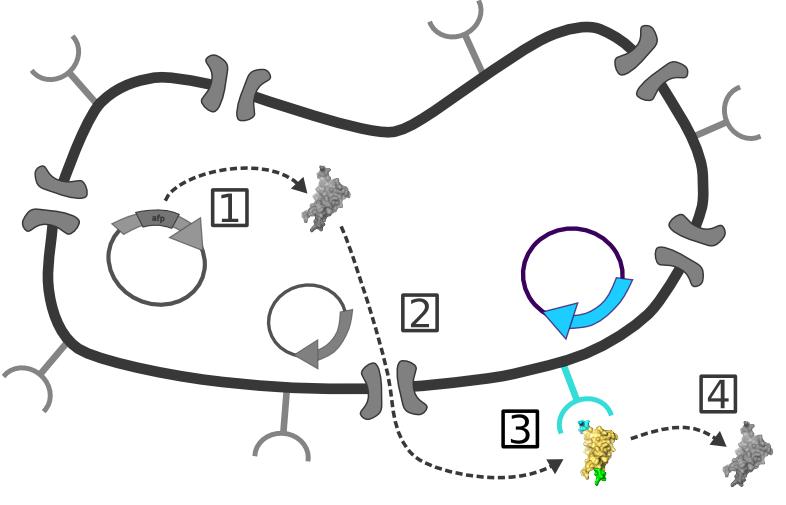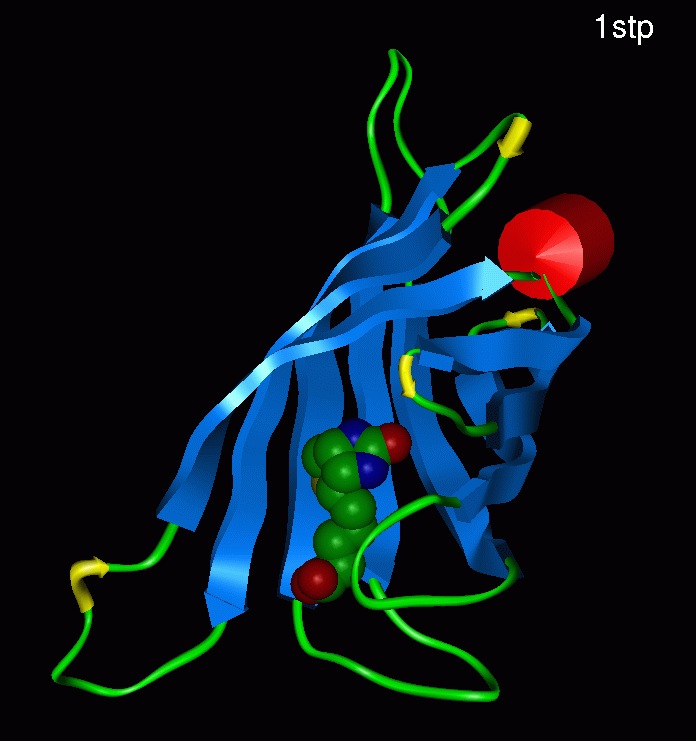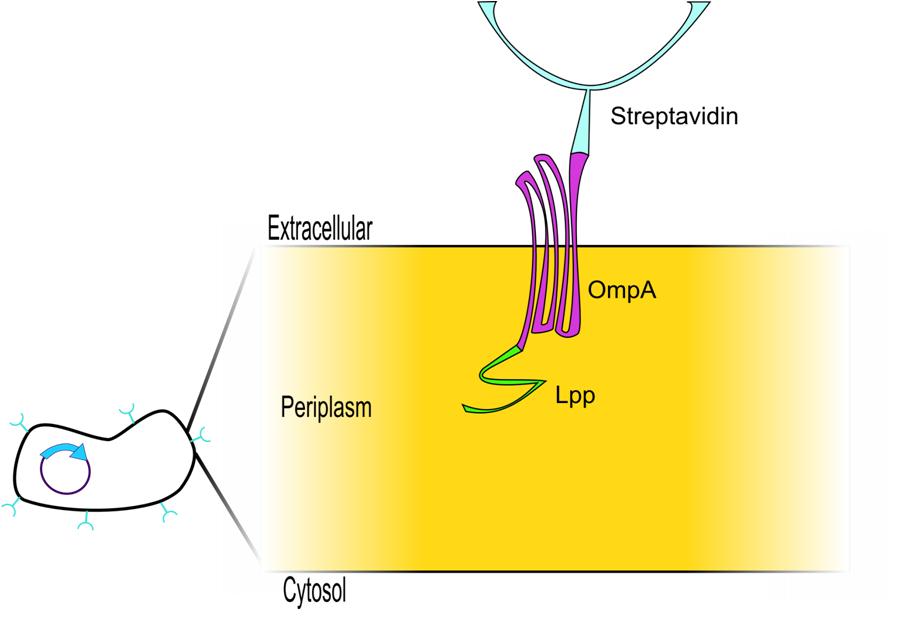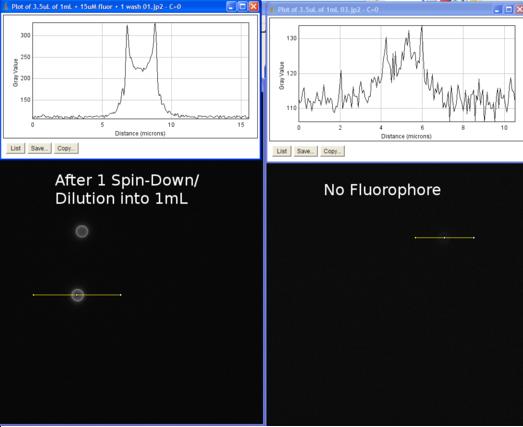Team:Washington/Project/Display
From 2009.igem.org
| Target Vector | Secretion System | Display System |
|---|
Display System
Background
Our system hinged on finding a protein which could bind other protines to the outside of the cell, but whose interaction with these proteins was weak enough to be disrupted by another small molecule. Streptavadin presented itself as a logical choice because it can bind biotin (a small molecule) as well as a nanotag sequence which can be added easily to any protein sequence [1]. The strepatavadin biotin complex is shown below.
- Image from Fritz Lipmann Institute (http://www.imb-jena.de/image_library/PROTEINS/proteins/1stp/)
Over viuew of strptavadin biotin binding [2].
Next we needed a way to anchor the streptavadin to the outer membrane. The obvious choice was to use the LPP signal peptide and Outer Membrane A (ompA) because it has been extensively studied. This LPP-ompA system has been used to display the following proteins:
- Green Fluorescent Protein (GFP) [3]
- Organophosphorus Hydrolase (OPH) [4]
- Cyclodextrin Glucanotransferase (CGTase) [5]
- Methyl Parathion Hydrolase (MPH) [6]
- Enhanced Green Fluorescent Protein (EGFP) [6]
Now we knew what we wanted. The next step was to chec the parts registry to see if someone had already built this part, or anything similar that we could use as a starting part for our Idealized Protein Purification system. Low and behold this system was already in the parts registry, and it was submitted by Harvard in 2006 []. In fact Harvard had submitted four biobrick parts which where of interest to us. They used a They submitted four biobricks which where all variations on the same theme. All four are fusion proteins which have a LPP signal peptide, either one or five trans-membrane ompA, and either monomeric or dimeric streptavidin. All the variations and the resulting biobricks are shown below.
| Bio Brick | OmpA trans-membrane domains | Type of Streptavadin |
|---|---|---|
| J36848 | 1 | monomeric |
| J36849 | 1 | dimeric |
| J36850 | 5 | monomeric |
| J36851 | 5 | dimeric |
A basic graphic of the structure of this display system is shown below:
In order to characterize how these parts worked, we ran the following tests:
- Western against the his tags on all of these proteins
- Micrscope Assay
- Flow Cytometry Assay
Experiments
Western
The goal of this experiment was to make sure that the proteins were being expressed in our cell lines, and also to make sure that they were the correct length. Here is our procedure for the preparation of the western.
Procedure
- Set up overnights of parts 48-51
- Dilute 1 ul overnight into 1ml
- Add 1 mm IPTG and let grow for four hours
- After cells have all grown up uniformly start boiling water for the boil step
- Add 100uL of overnight to a 1.5mL tube
- Pellet by spinning at max speed for 30 secs in the microcentrifuge
- discard supernatent
- Pull an aliquot of 5x sample loading buffer out of the freezer and thaw
- Add 20uL BME to aliquot
- Resuspend samples in 50uL sample loading buffer (pipette up/down)
- Boil samples for 10 minutes
- While boiling, prepare 500mL 1x SDS buffer:
- 50mL 10x buffer to 450mL water
- Take a gel out of the fridge and and put it in the gel box (keep the gel container for staining!!!)
- Pour the mixed buffer solution into the half of the gel box that the gel is in
- Remove the gel comb
- Fill the little container on the top of the gel until it's about 0.5 cm from the top with buffer
- Remove any bubbles in the wells
- Spin down samples for a few seconds
- Vortex samples
- Load 3uL into each well
- Load 10uL of ladder in appropriate wells
- Run at 180V until the dye is about to fall off the gel
Results
File:Western.jpg I know this is not annotated, but it will be on the real site
The expected values of each of these proteins are shown in the table below:
| Bio Brick | Length (in kD) |
|---|---|
| J36848 | 21478.7 |
| J36849 | 34600.9 |
| J36850 | 31215.4 |
| J36851 | 44972.3 |
From this data one can see that all of the bands from our proteins came out to be in the right locations. Thus our protein was being expressed.
Microscope Assay
The goal of this experiment was to see if we could confirm the presence of streptavadin on the outside of our cell. We wanted to do this using a biotyntalated flourophore. We expected that this flourophore would bind to the streptavadin on the outside of the cell in such a high level that we would be able to detect it under a high powered florescence microscope. As a positive control we used streptavadin coated beads which were roughly the same size (with respect to volume) as our cells (except spherical).
Procedure
- Set up overnights of parts 48-51. Let grow overnight.
- Dilute 1 ul overnight into 1ml
- Add 1 mm IPTG and let grow for four hours
- After cells have grown up, place in flourophore (1 um) and allow time to bind (1 hour)
- Also place 1 ul beads in 1 ml along with 1 ul flourophore.
- Allow beads to bind to flourophore, then spin beads down, remove supernatent and replace with 1 ml water.
- Next place the cells and the beads under the microscope
Data
From this data we can see that while the positive control did have a visible increase in florescence around the outside, the cells did not show any such increase.
Flow Cytometry
The goal of this experiment was to see how the biotin bonded to streptavadin over a whole population of cells. Where as the Microscope experiment looked at a few localized cells, we set the cytometer to look 50,000 cells or beads and read the resulting florescence.
Procedure
- Set up overnights of parts 48-51. Let grow overnight.
- Dilute 1 ul overnight into 1ml
- Add 1 mm IPTG and let grow for four hours
- After cells have grown up, place in flourophore (1 um) and allow time to bind (1 hour)
- Also place 1 ul beads in 1 ml along with 1 ul flourophore.
- Allow beads to bind to flourophore, then spin beads down, remove supernatent and replace with 1 ml water.
- Read the samples through the flow cytometer
Data
http://soslab.ee.washington.edu/igem/2009/images/f/f9/Hists.png File:2009-08-07 51s.png
Again this data showed us that we did not have any appreciable binding occurring with our display system to biotin at the global level
References
- TBA
- TBA
- Display of green fluorescent protein on Escherichia coli cell surface. Shi H, Wen Su W. Department of Biological & Agricultural Engineering, University of Missouri-Columbia, 65211, Columbia, MO, USAEnzyme Microb Technol. 2001 Jan 2;28(1):25-34.
- Cell surface display of organophosphorus hydrolase using ice nucleation protein. Shimazu M, Mulchandani A, Chen W. Biotechnol Prog. 2001 Jan-Feb;17(1):76-80. Department of Chemical and Environmental Engineering, and Environmental Toxicology Program, University of California, Riverside, CA 92521, USA.
- Anchorage of cyclodextrin glucanotransferase on the outer membrane of Escherichia coli. Wan HM, Chang BY, Lin SC. Biotechnol Bioeng. 2002 Aug 20;79(4):457-64. Department of Chemical Engineering, National Chung Hsing University, Taichung, 402, Taiwan.
- Cell surface display of functional macromolecule fusions on Escherichia coli for development of an autofluorescent whole-cell biocatalyst. Yang C, Zhao Q, Liu Z, Li Q, Qiao C, Mulchandani A, Chen W. Environ Sci Technol. 2008 Aug 15;42(16):6105-10. State Key Laboratory of Integrated Management of Pest Insects and Rodents, Institute of Zoology, Chinese Academy of Sciences, Beijing 100101, China.
 "
"





